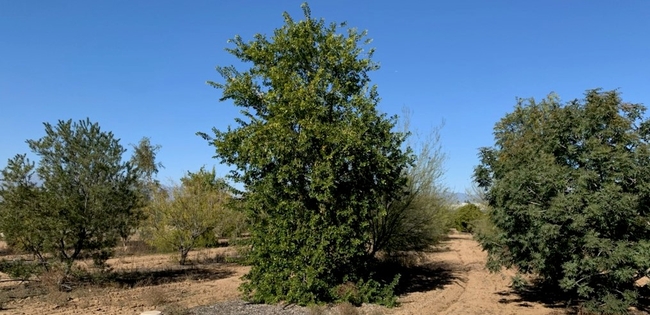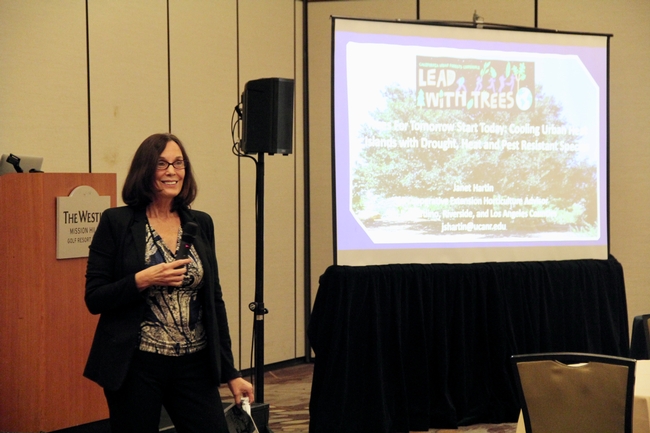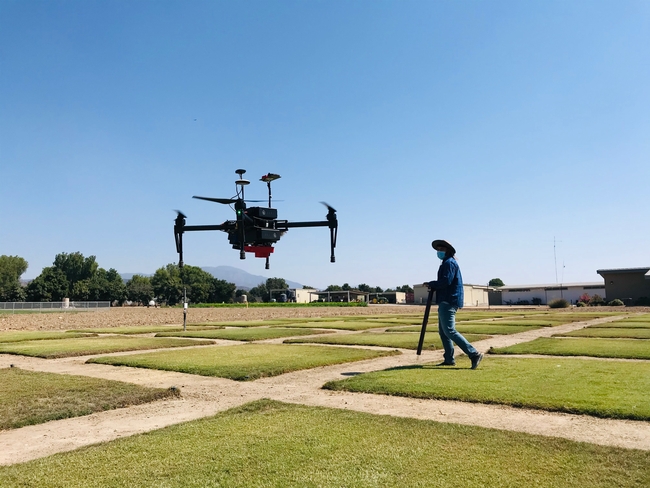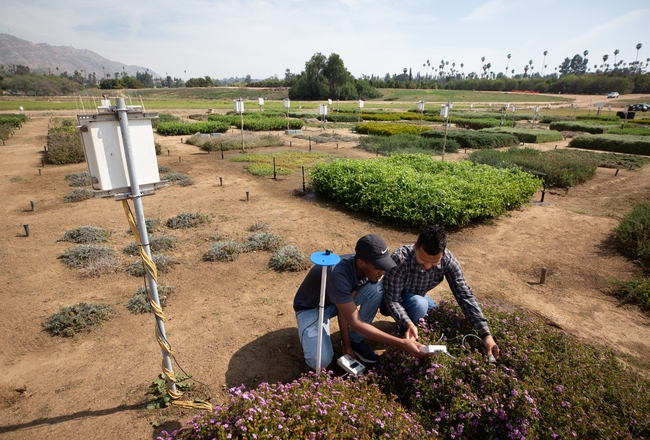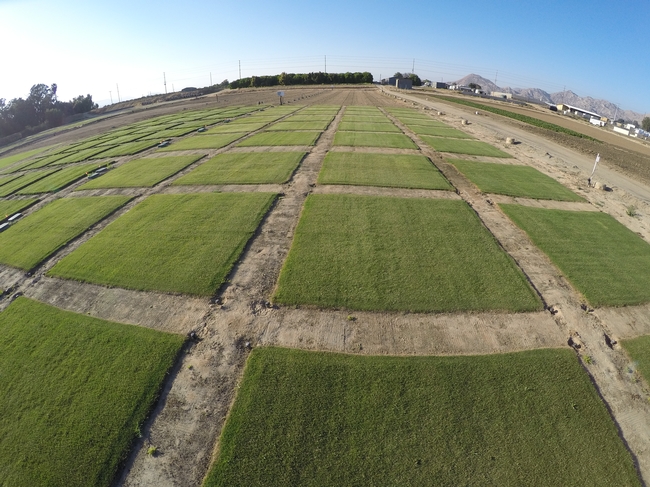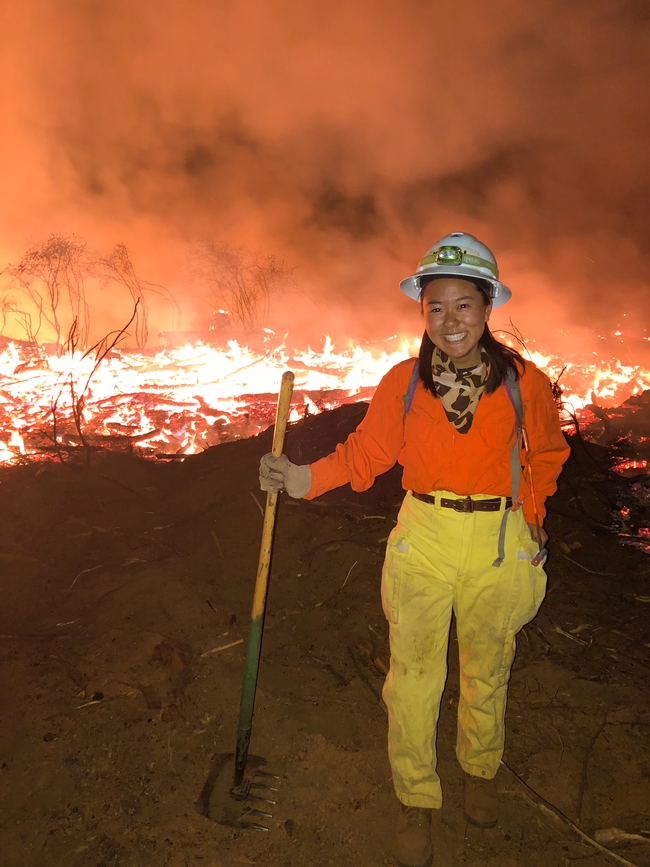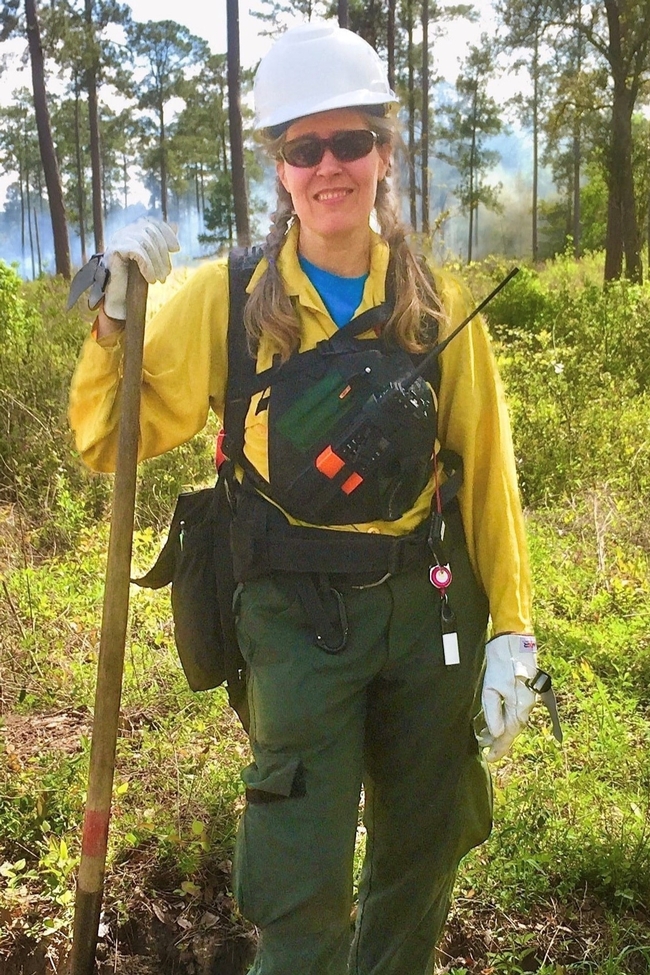Posts Tagged: Drought
Drought focus of Water Resources IMPACT magazine special issue
UC ANR experts address emotional toll of drought
Preparing the American West for prolonged drought is the focus of a double issue of Water Resources IMPACT magazine. The California Water Commission staff are guest editors for this special open-access edition of the magazine, which is published by the American Water Resources Association.
Faith Kearns, academic coordinator of University of California Agriculture and Natural Resources' California Institute for Water Resources, is among the authors delving into how drought impacts people and the environment and how we can better prepare for the inevitable.
The first issue, published on Feb. 14, focuses on water scarcity issues confronting California and the ways these issues affect different sectors.
In “Trauma, Care, and Solidarity: Addressing the Emotional Toll of Chronic Drought,” Kearns highlights the effects of drought on mental health. She points to the spike in suicide hotline calls when wells ran dry in Southeast Asian communities in California's Central Valley.
By listening to Southeast Asian farmers, Ruth Dahlquist-Willard and Michael Yang of UC Cooperative Extension were able to “lighten the load” for them by providing pragmatic support, Kearns writes.
“The scale of some of these highly emotional issues – drought, wildfires, climate change – can make them seem incredibly difficult, if not impossible, to deal with,” Kearns said. “At the same time, they are affecting everyone living in the western U.S. on a daily basis. I wanted to highlight and provide models based on work that people – whether they are researchers, clinical psychologists, or Cooperative Extension advisors – are doing right now to ease the way.”
The authors who contributed to the double issue are a diverse array of Tribal experts, academics, nongovernmental organization thought-leaders, water managers and water policy influencers, each of whom brings their own perspective on the topic of drought. Their expertise and perspectives in climate science, water policy and water management will help inform drought-related decision-making and support policies that better prepare the state to thrive during periods of prolonged water scarcity.
In addition to Kearns, the first issue includes articles contributed by:
- Samantha Stevenson, University of California, Santa Barbara
- Jay Lund, University of California, Davis
- Ron Goode, North Fork Mono Tribe
- Andy Fecko, Placer County Water Agency
- Jeff Mount, Public Policy Institute of California, and Ted Grantham, University of California, Berkeley/UC Cooperative Extension
- Nat Seavy and Karyn Stockdale, National Audubon Society
- Kjia Rivers, Community Water Center
- Cannon Michael, Bowles Farming
- Michelle Reimers, Turlock Irrigation District
The January/February edition of Water Resources IMPACT magazine can be accessed, free of charge, on the American Water Resources Association website at https://www.awra.org under “Publications.”
The second issue, to be published in March, will focus on drought response, considering the options for adaptation. This two-part series complements the Commission's work on strategies to protect communities and fish and wildlife in the event of a long-term drought.
Your water-efficient landscape doesn’t have to be barren
UC climate-ready landscape trials identify low-water yet attractive plants
Good news: roses can be a part of your water-efficient landscape. Lorence Oki, UC Cooperative Extension environmental horticulture specialist in the UC Davis Department of Plant Sciences, identified rose cultivars that remain aesthetically pleasing with little water.
Oki is the principal investigator of the Climate-Ready Landscape Plants project, which may be the largest irrigation trial in the western U.S., and the UC Plant Landscape Irrigation Trials (UCLPIT), the California component of that project. These projects evaluate landscape plants under varying irrigation levels to determine their optimal performance in regions requiring supplemental summer water.
“There are some assumptions that pretty plants use a lot of water, like roses,” Oki said. “Everyone thinks they need a lot of water, but we've found some that don't, and they still look great. A water-efficient landscape doesn't need to look like a Central Valley oak-grassland in the summer. It can look really attractive.”
In 2021, Oki's team at UC Davis identified Lomandra confertifolia ssp. pallida "Pom Pom" Shorty and Rosa "Sprogreatpink" Brick House® Pink as two of the best low-water plants in the trial.
“The useful tip or information that is shared at the end of each trial is the selection and designation of plants as Blue Ribbon winners. These are the plants that looked good with an overall rating of 4 or higher throughout and were on the low (20%) water treatment,” said Natalie Levy, associate specialist for water resources, who manages the project at the UC ANR South Coast Research and Extension Center.
How plants earn a blue ribbon
Each trial year, the selection of new plants is based on research recommendations and donated submissions from the nursery industry. The landscape plants are trialed in full sun or 50% shade cover.
Irrigation treatments are based on the rate of evaporation and plant transpiration (evapotranspiration) measured through a local California Irrigation Management Information System (CIMIS) weather station that provides a reference evapotranspiration (ETo) rate.
Three levels of irrigation are provided to the plants equal to 20%, 50%, and 80% of ETo. The volume of water applied is the same at each irrigation based on soil characteristics, but the interval between applications varies with weather and the treatment. Using this method, irrigations for the 20% treatment are less frequent than the 80% treatment.
“The 20% treatment during the 2022 trial was irrigated an average of once per month while the 80% treatment was irrigated weekly,” explained Levy.
During the deficit irrigation trial, monthly height and width measurements are taken to determine the plant growth index. Monthly qualitative aesthetic ratings on a scale of 1 to 5 are determined for foliage appearance, flowering abundance, pest tolerance, disease resistance, vigor and overall appearance.
A second round of flowering abundance and overall appearance measurements are also taken to capture more of the blooming period. For example, UCLPIT identified in the 2020 trial at South Coast REC that the "Apricot Drift" rose had a mean overall appearance score of 3.5 out of 5, deeming it “acceptable to very nice” and a low water use plant within the Water Use Classification of Landscape Species or WUCOLS guide.
Project expands options for landscape planting
“(WUCOLS) only has 3,500 plants in it. There are guesses that there are close to 10,000 cultivars in urban landscapes in California, if not more,” said Oki. “WUCOLS also didn't have numerical ratings. Instead, you'll see verbal ratings like ‘low water use' or ‘high water use.'”
The UCLPIT project has not only developed numerical recommendations for irrigation, but it has also added new landscape plants that are compliant with California's Model Water Efficient Landscape Ordinance. In fact, UCLPIT's data is one of the few sources that can be used to supplement WUCOLS.
Geographic diversity of trial sites adds to knowledge base
In addition to UC Davis and South Coast REC in Irvine, the trials have expanded beyond California as the Climate-Ready Landscape Plants project and is in progress at Oregon State University, University of Washington, University of Arizona and Utah State University thanks to a USDA/CDFA grant awarded in 2020.
Lloyd Nackley, associate professor of nursery production and greenhouse management at Oregon State University, is the principal investigator of the trial in the Portland metro area, which is entering its third year.
“People know that there are drought tolerant plants, but there are many. We're trying to highlight lesser known or newer varieties. And even though the trial is three years, most gardeners would hope that their garden lasts longer than that,” said Nackley.
One of the observations that Nackley recalls is of the Hibiscus Purple Pillar plant. Unlike the trial at South Coast, the Purple Pillar did not perform well in Oregon in the spring.
“It wasn't until August that we saw the plant bloom and begin to look like what we saw from South Coast in April,” Nackley said.
Ursula Schuch, horticulture professor and principal investigator of the trial taking place at the University of Arizona, was also surprised at the range of performance among different plant types and the effects of irrigation, heat and temperature.
“This research will reassure green industry professionals that they can stretch their water budget to successfully cultivate more plants, watering them according to their needs instead of irrigating every plant according to the highest water-using plants,” said Schuch.
Although research is only conducted in the West, the hope is that there will be trials in other regions of U.S.
Doing so would yield comprehensive information about the plants and their performance in different climates. As extreme weather events persist in the U.S., disease pressure and risks do too. Trials throughout the country would provide location-specific data regarding disease susceptibility.
To learn more about the UCLPIT research project, visit https://ucanr.edu/sites/UCLPIT/
Now is the time to plant climate-ready trees, says UCCE researcher
In a drought-prone region like Southern California, working with Mother Nature is not only wise but necessary, according to Janet Hartin, UC Cooperative Extension horticulture advisor for Los Angeles, San Bernardino and Riverside counties, who studies climate-ready trees.
In 2020, Governor Newsom launched the California Climate Action Corps, empowering Californians to protect their communities from the impacts of climate change. Newsom's call to action emphasizes the need for long-term and sustainable solutions like Hartin's research, which urges Southern California to care for existing trees and plant new ones.
In collaboration with the U.S. Forest Service and other UC Cooperative Extension scientists, Hartin is amid a 20-year research study identifying trees suitable for California's different climate zones. Her work provides a comprehensive understanding of trees and their benefits related to human and environmental health, particularly as Californians navigate climate change's evolving challenges.
One of these concerns is urban heat islands. UHIs are areas in which heat is reradiated from paved concrete or asphalt surfaces. In cities covered in asphalt, like Los Angeles, average temperatures can become six degrees hotter than surrounding areas.
To reduce urban heat islands, she has been working with community organizations to plant trees. In March, for example, Hartin teamed up with the Inland Empire Resource Conservation District to increase tree canopy in the Inland Empire.
“We've collaborated extensively with her over the years, and we knew Janet had been developing a regionally scaled concept for connecting community members to climate-appropriate trees, alongside access to technical assistance from regional UCCE Master Gardeners to ensure long-term tree health and survival,” said IERCD District Manager Mandy Parkes.
Trees keep cities cool
To keep the city cool, some Los Angeles neighborhoods are repainting pavements with reflective coating. According to a 2020 study published in Environmental Research Letters, reflective coating can decrease pavement temperatures up to 10 degrees. As helpful as this is, augmenting urban landscapes to include heat-, drought- and pest-resistant tree species, whether native or not, can significantly reduce the impacts of urban heat islands too.
“Trees can cool impervious surfaces by 40 to 65 degrees,” Hartin said. During a 2021 study, in May and June Hartin discovered that unshaded asphalt could be more than 60 degrees hotter than shaded asphalt during late spring and early summer in inland and desert cities.
Other than providing shade, trees are effective at deflecting the sun's radiation and cooling the atmosphere through evapotranspiration. Given that they absorb and store carbon as well, trees lessen the impacts of pollution from fossil fuels.
“A well-tended mature landscape tree can absorb 40 tons of carbon over its lifespan,” said Hartin.
In a 2021 blog post, Hartin suggests trees be selected based on their adaptation to the “micro-climate” in each particular landscape, noting factors to consider like shade, proximity to buildings, space needs below and above ground, soil type and water source. She also recommends the Sunset Western Climate Zone maps for reference, noting that they are “more precise than USDA zones for our warmer climates.”
Based on the study with the U.S. Forest Service examining the performance of 12 species of underplanted but promising landscape trees at UC Riverside, favorable candidates include bubba desert willow and maverick thornless honey mesquite for their drought resistance, and red push pistache for its drought and heat resistance.
Tamara Hedges, executive director of UC Riverside Palm Desert Center and member of the Board of Directors for the Oswit Land Trust, agrees that trees are important in our fight against climate change:
“Through our partnerships with the UC California Naturalist and the Master Gardener Programs and many other nonprofits in the Coachella Valley, natural ecosystems are being protected and expanded and built environments cooled through the planting of appropriate tree species. These UC/USFS studies go a long way in identifying new underrepresented tree species."
General tips for planting
For California, planting in early fall through late winter provides ample time for trees to establish a strong root system before enduring the summer heat. Doing so also means that natural rainfall can fulfill water needs, as opposed to solely relying on irrigation systems.
Unlike newly planted trees, mature trees should be watered infrequently but deeply. Watering too often can reduce the level of oxygen in the rootzone and result in waterlogged soils prone to crown and root rots.
During the fall, trees only need about 15% of the water they would require in the summer. When watering, keep the tree trunk dry. Because the roots of the tree grow outward and are usually a foot deep into the ground, Hartin recommends watering the area around the trunk rather than the trunk itself. This will also help avoid water waste.
“Trees not adapted to the climate they're planted in and not receiving proper care are much more susceptible to invasive pests like shothole borers and diseases,” said Hartin. “Even the loss of one front yard tree can significantly reduce shade, increase the surrounding temperature, and diminish energy savings.”
UCCE water management expert helps save water, increase supply in SoCal
Earlier this year, officials in Southern California declared a water shortage emergency resulting in restrictions such as limiting outdoor water use to one day of the week. While mandatory restrictions vary across the region, Amir Haghverdi, UC Cooperative Extension specialist and associate professor of agricultural and urban water management at UC Riverside, is using research to pinpoint irrigation strategies that will help communities reduce their demand for water and increase supply.
Haghverdi and his team are responding to a hotter and drier California by working to identify changes that can make a substantial difference in water savings.
While behavioral changes such as preventing leaks and turning the faucet off while brushing teeth can help, Haghverdi's research focuses on methodical changes like stressing green spaces, planting drought-tolerant plant species, using non-traditional water sources, and investing in technology to better control water use.
Testing a lawn's limits
For six years, Haghverdi and his team have performed stress tests on turfgrass to identify the lowest percent of evapotranspiration rate (ETo) that it can withstand and still survive. To do this, Haghverdi's team applies different percentages of ETo, obtained from weather stations, and monitors the performance of each landscape species over time.
While both cool-season and warm-season species can be stressed and still maintain their aesthetic value for a few weeks to several months, Haghverdi's results showed that warm-season turfgrass species require less water and can withstand water stress better.
The actual duration that people can apply less water depends on the type of turfgrass, the weather conditions and the stress level. For example, results showed that hybrid bermudagrass (a warm-season turfgrass) during summer in inland Southern California could keep its aesthetic value above the minimum threshold for 30 to 50 days, depending on the weather conditions, with irrigation application as low as 40% ETo.
In contrast, tall fescue, a cool-season turfgrass, even with 20% more water, showed signs of stress after only a few weeks and could not maintain its minimum acceptable quality.
Plant drought-tolerant species
Haghverdi's work demonstrates that when water conservation is the goal, alternative groundcover species are clearly superior to all turfgrass species and cultivars that they have tested so far. In fact, his team has identified drought-tolerant species that can maintain their aesthetic values with a third to a quarter less water than cool-season turfgrass (as low as 20% ETo) and can even withstand no-irrigation periods.
Furthermore, extensive field trials showed that new plant species from different regions could be as resilient as native species in withstanding drought and heat stress while maintaining their aesthetic beauty and cool canopy. Occasionally, they have outperformed native species, underscoring the advantages of drought- and heat-tolerant species that are non-native.
Based on Haghverdi's preliminary results for minimum irrigation requirement in inland Southern California, creeping Australian saltbush, a non-native species originally from Australia, and coyote bush, native to California, were top performers. Considering cooling benefits, drought tolerance and sensitivity to over-irrigation, creeping Australian saltbush performed the best.
Counties are already using recycled water
Although he recommends renewing your landscape with drought-tolerant or low-water use greenery and identifying how long your green spaces can live without water, Haghverdi acknowledges that, while contradictory, the cooling benefits of landscape irrigation are essential in Southern California.
“This is one of the tradeoffs of water conservation,” said Haghverdi. “If the only goal is to conserve water, maybe people will conclude that we don't have enough water to irrigate landscape.”
Water conservation efforts could influence counties to stop or reduce landscape irrigation. The consequences, however, would result in hotter environments due to the heat island effect. The loss of landscapes means that the sun's energy will be absorbed into the ground, instead of prompting transpiration in plants, which helps keep environments cool.
Thus, stressing green spaces and investing in drought-tolerant plant species help reduce the demand for water, but increasing water supply is just as vital. Haghverdi urges Southern California counties to prioritize a supplemental water supply such as recycled water – an approach already implemented in Ventura, Orange and San Diego counties.
The Metropolitan Water District of Southern California's Pure Water Southern California Program, formerly known as the Regional Recycled Water Program, aims to do just that. In partnership with the Los Angeles County Sanitation Districts, the program will further purify wastewater to produce a sustainable source of high-quality water for the region.
According to the program's website, this would “produce up to 150 million gallons of water daily when completed and provide purified water for up to 15 million people, making it one of the largest water reuse programs in the world.”
Smart controllers save time, money and water
Making the best use of the water you already have relies on efficiency. Sprinklers that are poorly placed, for example, are not as effective as they could be.
“What I see often while walking my dog in the neighborhood is that there's a lot of runoff, bad irrigation and bad timing like when it's windy,” Haghverdi observed. “People usually set their irrigation timer and then forget it, but they don't adjust it based on the season or weather parameters. That's not going to help us conserve water, a precious resource, in California.”
Thankfully, Haghverdi and his team have done extensive research on smart irrigation controllers, which, simply put, are irrigation timers with a sensor built in. Generally, there are two types of smart irrigation controllers: weather- and soil-based controllers.
Weather-based controllers use evapotranspiration data to automatically adjust their watering schedule according to local weather conditions. Soil-based controllers measure moisture at the root zone and start irrigating whenever the reading falls below a programmed threshold.
Smart controllers that have flowmeters can detect leaks and be activated automatically, whereas rain sensors can stop irrigation during rainfall. Although both additions are ideal for large irrigation landscapes such as parks and publicly maintained green spaces, rain sensors are easy to install and effective for residential areas too.
When asked about cost being a hindrance, Haghverdi responded, “Not a lot of people know that there are grants for smart controllers – some that will pay either all or a majority of the cost.”
To check if grants are available in your area, interested individuals are encouraged to contact their local water provider.
“We need to move towards autonomous and smart irrigation [strategies], and water management in urban areas. That's the future. If we can build autonomous cars, why can't we build smart water management systems that apply the right amount of water to each plant species, can detect leaks and prevent water waste?” said Haghverdi.
To learn more about or stay updated on Haghverdi's research, visit www.ucrwater.com.
New advisors share crucial wildfire expertise
UC ANR hires more fire advisors to address growing threat to California communities
Bringing more expertise to more places across the state, University of California Agriculture and Natural Resources continues to hire fire advisors to help communities prepare for one of the most devastating climate-fueled threats.
With wildfires a constant danger as drought grips California, five highly skilled UC Cooperative Extension experts have joined the organization since early May:
- Katie Low, statewide fire coordinator (and also serving Nevada and Placer counties)
- Alison Deak, fire advisor serving Mariposa, Fresno and Madera counties
- Tori Norville, fire advisor serving Sonoma, Napa and Marin counties
- Barb Satink Wolfson, fire advisor serving Monterey, San Benito, Santa Clara and Santa Cruz counties
- Luca Carmignani, fire advisor serving Los Angeles and Orange counties
These positions – as well as other recent additions in agriculture and natural resources fields – are made possible by California's commitment, as reflected in the state budget, to improve the lives of residents in the face of a changing climate.
This robust team of fire experts provide broad knowledge and practical advice on a wide range of topics, including fire hazard mitigation, fire ecology, prescribed fire, wildland fire research, forest and wildlife management, and climate change effects.
Although their specific areas of expertise vary, all the new fire advisors are dedicated to helping residents and community groups across California become more fire-aware, adapted and resilient. They share vital information on how Californians can prepare homes, landscapes and property for wildfire.
Katie Low
Katie Low, who began as the University of California Cooperative Extension statewide fire coordinator on Sept. 1, will fulfill two important functions for UC Agriculture and Natural Resources' team of fire experts.
First, she will coordinate and partner with UCCE fire advisors throughout California to develop and deliver wildfire-related science and outreach materials for a wide range of communities across the state. Low said encouraging diversity in the network of fire experts and engaged communities will be crucial.
“One of my goals is to help build and maintain a diverse and inclusive community of fire and natural resource professionals,” she said.
Based at the UCCE office in Auburn, Low also will collaborate with local natural resource professionals and residents in Nevada and Placer counties on projects that bolster community and ecosystem resilience to wildfire and climate change.
“I look forward to working with community groups, land managers and scientists to implement viable fire-resilient management strategies for ecosystems in the region and statewide,” Low said.
Equipped with bachelor's degrees in geography and ecosystems management and forestry, as well as a master's in forestry, all from UC Berkeley, Low brings to UC ANR a wealth of knowledge and a variety of experience.
As a fire and forest ecologist, she studied the impacts of fuels-reduction and forest-restoration treatments on Sierra Nevada mixed-conifer forests. Low also worked as operations coordinator for the California Outdoor Engagement Coalition, and as a forestry aide for California Department of Forestry and Fire Protection's Forest Biometrics Program.
Low can be reached at 530-889-7385 and katlow@ucanr.edu; follow her on Twitter @lowseverityfire.
Alison Deak
Alison Deak joined UC Cooperative Extension in August 2022 as a fire advisor for Mariposa, Fresno and Madera counties. Since she began work, Deak has been focused on conducting a needs assessment and building rapport with community leaders.
Her role as fire advisor will include promoting the use of prescribed fire to help restore fire adapted landscapes. She will also prioritize community education, applied research and partnership building efforts that are based on scientifically informed ways to help communities mitigate, prepare for, and recover from wildfire.
Originally from northeast Ohio where there are no wildfires according to Deak, it was not until she moved to Colorado for college that she learned of their impact.
When the 2012 Waldo Canyon Fire occurred, Deak felt like her playground was burning down so she acted. She began volunteering with the wildfire recovery effort and her career into fire science took off from there.
Deak earned a bachelor's in geography and environmental studies from the University of Colorado in Colorado Springs and master's degrees in geography and nonprofit management from the University of Oregon.
Before moving to California and joining UC ANR, Deak worked as a wildland firefighter with the United States Forest Service and Bureau of Land Management.
When asked what she is looking forward to most, Deak shared that she is passionate about increasing diversity in the fire science field and, particularly, empowering more women to join. She is eager to help community members prepare for wildfire and mitigate fire risk in a safe and competent manner.
Deak is located at the UC Cooperative Extension office in Mariposa County and can be reached at aldeak@ucanr.edu.
Tori Norville
Tori Norville started on Aug. 1 as the new UC Cooperative Extension fire advisor for Sonoma, Napa and Marin counties.
In this capacity, Norville will work with residents and organizations within the wildland-urban interface to encourage and cultivate fire-adapted communities. She aims to provide education and outreach on home hardening, defensible space and the importance of forest and fuel management on the landscape.
While pursuing her bachelor's degree in forestry and natural resources at Cal Poly San Luis Obispo, Norville became interested in “disturbance ecology” – how factors such as disease, insects and fire affect landscapes and environments.
“Many of the forest health problems we are seeing are stemming from a lack of disturbance, which traditionally was fire,” Norville said.
Her understanding of fire and its effects deepened during her master's degree studies in forestry science (also at Cal Poly SLO), as well as through her seven years with CAL FIRE at the Jackson Demonstration State Forest in Mendocino County. She worked as the Registered Professional Forester for its Timber Sales Program, and then the Research and Demonstration Program.
Norville's firsthand experiences from the past few fire seasons have helped shape her goals and approach. She hopes to “work holistically with disturbances” – specifically fire – on the landscape to foster healthy forests and ecosystems that are adaptable and resilient, while also researching the environmental and social aspects of fuel-reduction projects and prescribed fire.
“Hopefully, I can begin to change the perception of fire from something we need to fear, to something we respect,” she said.
Norville, based at the UCCE office in Santa Rosa in Sonoma County, can be reached at trnorville@ucanr.edu.
Barb Satink Wolfson
Barb Satink Wolfson began in her role as UC Cooperative Extension fire advisor for Monterey, San Benito, Santa Clara and Santa Cruz counties on June 30.
Her primary responsibilities include wildland fire-related research and outreach for the Central Coast region, while building trust, strong partnerships and collaborative relationships within both professional and non-professional communities.
Satink Wolfson earned her B.S. and M.S. in forestry from Northern Arizona University, and brings to UC ANR more than 20 years of fire-research and outreach experience in Arizona. Her favorite job, though, was working as a backcountry ranger in Yosemite National Park during her undergraduate years.
In her new role, Satink Wolfson hopes to address some of the questions behind the use of prescribed fire in a variety of ecosystems (such as coastal prairies and oak woodlands), and help all Central Coast communities build resilience to wildland fire so residents can live safely within fire-adapted landscapes.
Satink Wolfson, based at the UCCE office in Hollister, can be reached at bsatinkwolfson@ucanr.edu.
Luca Carmignani
Luca Carmignani joined UCCE as a fire advisor for Orange and Los Angeles counties May 2. His research interests include image analysis, computer programming and scientific outreach.
Prior to joining UC ANR, Carmignani was a postdoctoral researcher in the Berkeley Fire Research Lab at UC Berkeley. His research has focused on fire and combustion applications, from wildland fires to material flammability.
He earned his Ph.D. in engineering sciences from the joint doctoral program between UC San Diego and San Diego State University after obtaining his bachelor's and master's degrees in aerospace engineering from the University of Pisa in Italy.
Carmignani is based at South Coast Research and Extension Center in Irvine and can be reached at carmignani@ucanr.edu and (949) 237-2956. Follow him on Twitter @l_carmignani.








